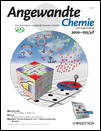Block Copolymers Comprising π-Conjugated and Liquid Crystalline Subunits: Induction of Macroscopic Nanodomain Orientation†
We acknowledge financial support from the Natural Sciences and Engineering Research Council of Canada (NSERC) and le Fonds québécois de la recherche sur la nature et les technologies (FQRNT, Québec). Y.Z. is a member of the FQRNT-funded Center for Self-Assembled Chemical Structures. We also thank Mrs. Rodica Neagu-Plesu (Laval University) for help with the X-ray diffraction measurements.
Graphical Abstract
Einmal um den Block: Ein Blockcopolymer enthält regioreguläres Poly(3-hexylthiophen) (P3HT) und ein Azobenzol-haltiges Flüssigkristallpolymer (SCLCP) in der Seitenkette. Weil die Klärtemperatur des SCLCP-Blocks über der Schmelztemperatur von P3HT liegt, können die Oberflächen- und lichtinduzierte Ausrichtung von Mesogenen im SCLCP-Block zur Anordnung streifenförmiger P3HT-Nanodomänen genutzt werden (siehe Phasenkontrast-AFM-Bild).





